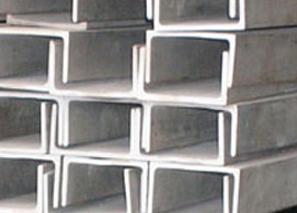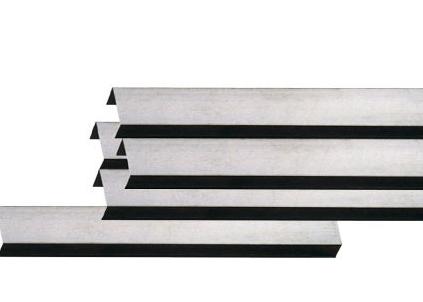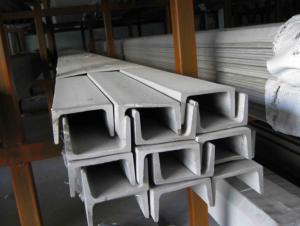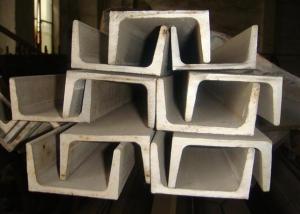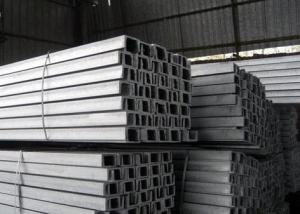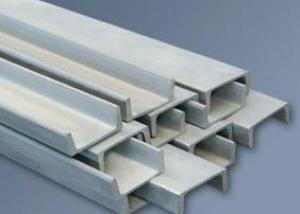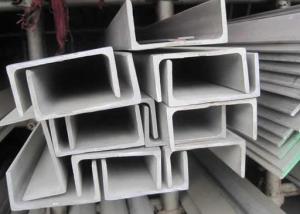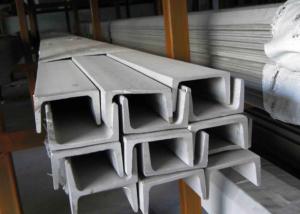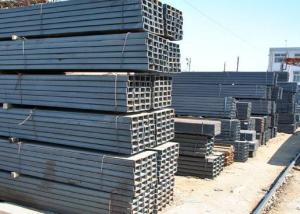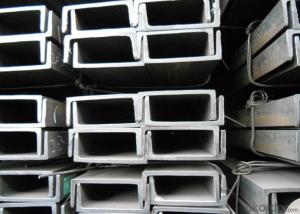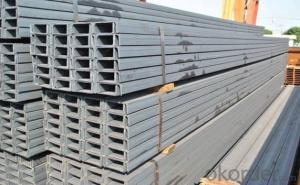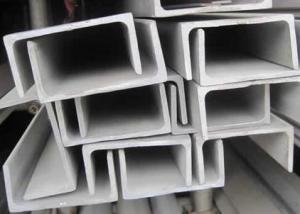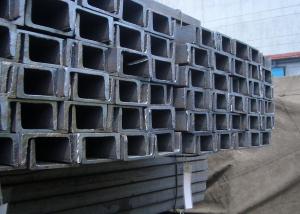Steel Channels
- Loading Port:
- China Main Port
- Payment Terms:
- TT or LC
- Min Order Qty:
- 5 Tons m.t.
- Supply Capability:
- 1000 Tons Per Month m.t./month
OKorder Service Pledge
OKorder Financial Service
You Might Also Like
Stainless Steel Channel
1.Size: 3mm to 24mm Thickness
2.Material:SUS201,202,301,304,304L,316,316L ,321 etc.
3.Length: 4m to 6m,or according to the customer's requirement
4.Standard: AISI,JIS,GB,DIN
5.Finish: Cold Drawn ,hot rolled & Polishing
6.Testing: Each heat number and batch must be tested for both chemical and mechanical properties
7.Application: Produce screw and nut, engine parts, indoor and outdoor decorating etc..
|
Size (mm) |
Thickness (mm) | |||||||||
|
H×B |
3 |
4 |
5 |
6 |
7 |
8 |
9 |
10 |
12 | |
|
Mass (Kg/m) | ||||||||||
|
40×20 |
1.79 |
|
|
|
|
|
|
|
| |
|
50×25 |
2.27 |
|
|
|
|
|
|
|
| |
|
60×30 |
2.74 |
3.56 |
4.37 |
5.12 |
|
|
|
|
| |
|
70×35 |
3.23 |
4.21 |
5.17 |
6.08 |
|
|
|
|
| |
|
80×40 |
3.71 |
4.84 |
5.96 |
7.03 |
|
|
|
|
| |
|
90×45 |
4.25 |
5.55 |
6.83 |
8.05 |
|
|
|
|
| |
|
100×50 |
4.73 |
6.18 |
7.62 |
8.98 |
10.3 |
11.7 |
13 |
41.2 |
| |
|
120×60 |
|
|
9.2 |
10.9 |
12.6 |
14.2 |
|
|
| |
|
130×65 |
|
|
10.1 |
11.9 |
13.8 |
15.5 |
17.3 |
19.1 |
| |
|
140×70 |
|
|
|
12.9 |
14.9 |
16.8 |
18.8 |
20.7 |
| |
|
150×75 |
|
|
|
13.9 |
16 |
18.1 |
20.2 |
22.2 |
26.3 | |
|
160×80 |
|
|
|
14.8 |
17.1 |
19.3 |
21.6 |
23.8 |
28.1 | |
|
180×90 |
|
|
|
16.7 |
19.4 |
22 |
24.5 |
27 |
32 | |
|
200×100 |
|
|
|
18.6 |
21.6 |
24.5 |
27.4 |
30.2 |
35.8 | |


- Q: Are stainless steel channels suitable for framing modular structures?
- Yes, stainless steel channels are suitable for framing modular structures. Stainless steel is known for its durability, strength, and corrosion resistance, making it an ideal choice for framing structures that need to withstand various environmental conditions. Additionally, stainless steel channels offer excellent structural stability and can support heavy loads, making them suitable for modular structures that require a strong and secure frame. Moreover, stainless steel has a sleek and modern appearance, which can enhance the overall aesthetic of the modular structure. Overall, stainless steel channels provide a reliable and versatile framing solution for modular structures.
- Q: Can stainless steel channels be used for elevator or escalator components?
- Yes, stainless steel channels can be used for elevator or escalator components. Stainless steel is a durable and corrosion-resistant material, making it suitable for these applications.
- Q: Are stainless steel channels suitable for use in the water distribution industry?
- Yes, stainless steel channels are suitable for use in the water distribution industry. Stainless steel is a highly durable and corrosion-resistant material, making it ideal for applications in water distribution systems. It can withstand exposure to various water conditions, including high temperatures, chemicals, and salts, without deteriorating or rusting. Additionally, stainless steel channels offer superior strength and longevity, ensuring long-term reliability and minimal maintenance needs. These channels also provide hygienic properties, as stainless steel is resistant to bacterial growth and easy to clean. Overall, stainless steel channels are a dependable and efficient choice for the water distribution industry.
- Q: What are the different methods of cutting stainless steel channels?
- There exist multiple techniques for cutting stainless steel channels, each with its unique advantages and factors to consider. 1. Shearing: A frequently employed method for cutting stainless steel channels is shearing. It entails the utilization of a sharp blade to slice through the material. This technique is well-suited for straight cuts and can be applied to both thin and thick stainless steel channels. However, shearing may cause some distortion of the cut edge and is unsuitable for precision cutting. 2. Sawing: Another approach for cutting stainless steel channels is sawing. This can be performed manually using a hacksaw or with power tools like a circular saw or bandsaw. Sawing allows for accurate cuts and can accommodate both straight and curved cuts. Nonetheless, it may produce a rough edge and generate a significant amount of heat, which can impact the properties of the stainless steel. 3. Laser cutting: A highly accurate and efficient technique for cutting stainless steel channels is laser cutting. It involves utilizing a powerful laser beam to melt or vaporize the material along the desired cutting path. Laser cutting provides clean and precise cuts, reduces the risk of distortion, and allows for intricate shapes and designs. However, it can be a costly method and may not be feasible for all budgets. 4. Plasma cutting: Plasma cutting is a versatile method used to cut stainless steel channels. It utilizes a rapid jet of ionized gas, known as plasma, to penetrate the material. Plasma cutting is fast, efficient, and can handle various thicknesses. Nevertheless, it may result in a wider heat-affected zone compared to other techniques, which can impact the material's properties. 5. Waterjet cutting: Waterjet cutting involves using a high-pressure stream of water mixed with abrasive particles to cut through stainless steel channels. This method provides excellent precision, minimal heat generation, and can accommodate different shapes and materials. Waterjet cutting is ideal for intricate designs and can produce smooth, burr-free edges. However, it may be a slower process compared to other methods and may not be cost-effective for large-scale production. When selecting the appropriate technique for cutting stainless steel channels, factors such as budget, desired precision, speed, and material thickness should be taken into account. It is advisable to consult with a professional or experienced fabricator to determine the most suitable method for your specific requirements.
- Q: Can stainless steel channels be used for curtain wall supports?
- Indeed, curtain wall supports can utilize stainless steel channels. Given its durability and resistance to corrosion, stainless steel proves to be an appropriate material for endeavors necessitating both structural support and long-lasting performance. By tailoring the design and production of these channels to meet the precise demands of curtain wall systems, they can fortify the structure, imbuing it with strength and stability. Moreover, the sleek and contemporary appearance of stainless steel channels enhances the overall aesthetic appeal, rendering them a prime selection for architectural projects involving curtain wall supports.
- Q: Can stainless steel channels be used in the construction of storage tanks?
- Stainless steel channels are indeed applicable for the construction of storage tanks. Renowned for their robustness, resistance to corrosion, and strength, stainless steel proves to be an optimal material for such tanks. By supplying structural reinforcement, the channels guarantee the tank's stability and integrity. Furthermore, the ease of cleaning and maintenance associated with stainless steel channels is imperative for storage tanks that potentially house diverse substances. In conclusion, stainless steel channels are an unquestionably dependable and appropriate option for the construction of storage tanks.
- Q: Do stainless steel channels have a high strength-to-weight ratio?
- Yes, stainless steel channels have a high strength-to-weight ratio. Stainless steel is known for its exceptional strength and durability, making it an ideal material for structural applications that require both strength and light weight.
- Q: How do stainless steel channels perform in saltwater environments?
- Stainless steel channels perform exceptionally well in saltwater environments due to their inherent corrosion resistance properties. The chromium content in stainless steel forms a protective passive layer on the surface, preventing the material from rusting or corroding when exposed to saltwater. This passive layer acts as a barrier against the corrosive effects of saltwater, making stainless steel channels highly resistant to pitting, crevice corrosion, and chloride stress corrosion cracking. The high resistance to corrosion makes stainless steel channels ideal for various applications in saltwater environments such as marine construction, offshore oil platforms, coastal structures, and waterfront infrastructure. They can withstand the harsh conditions, including the presence of saltwater, waves, and constant exposure to moisture, without losing their structural integrity or requiring frequent maintenance. Moreover, stainless steel channels offer excellent mechanical properties, including high strength and durability, further enhancing their performance in saltwater environments. They can withstand the mechanical stresses and pressures exerted by the sea, such as waves, tides, and currents, without significant deformation or failure. Additionally, stainless steel channels have a long lifespan in saltwater environments, as they do not degrade or deteriorate easily over time. This durability reduces the need for frequent replacements, resulting in cost savings in the long run. Furthermore, stainless steel is a sustainable material that is 100% recyclable, making it an environmentally friendly choice for saltwater applications. In conclusion, stainless steel channels are highly reliable and efficient in saltwater environments. Their corrosion resistance, mechanical strength, durability, and sustainability make them an ideal choice for various marine and coastal applications, providing long-lasting performance even in the harshest saltwater conditions.
- Q: Are stainless steel channels suitable for electrical conduits?
- Yes, stainless steel channels are suitable for electrical conduits. Stainless steel is known for its high resistance to corrosion, durability, and strength, making it an excellent choice for protecting electrical wires and cables. It provides reliable protection against moisture, chemicals, and physical damage, ensuring the safety and longevity of electrical installations.
- Q: Can stainless steel channels be used for rooftop installations?
- Yes, stainless steel channels can be used for rooftop installations. Stainless steel is a durable and corrosion-resistant material, making it ideal for outdoor applications such as rooftop installations. It can withstand exposure to various weather conditions, including rain, snow, and sunlight, without rusting or deteriorating. Stainless steel channels provide structural support and stability, making them suitable for securely mounting equipment or conduits on rooftops. Additionally, stainless steel's sleek and polished appearance adds an aesthetic appeal to rooftop installations.
Send your message to us
Steel Channels
- Loading Port:
- China Main Port
- Payment Terms:
- TT or LC
- Min Order Qty:
- 5 Tons m.t.
- Supply Capability:
- 1000 Tons Per Month m.t./month
OKorder Service Pledge
OKorder Financial Service
Similar products
Hot products
Hot Searches
Related keywords




